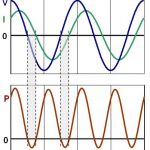How Power Factor and Harmonics relate to Energy Efficiency?
In an AC distribution system, the maximum active power is transmitted to a load when voltage and current are undistorted and in phase.
When voltage and current are phase-shifted as illustrated on figure 2, the instantaneous power P = V x I is negative during the intervals where the signal signs are opposite. The average power is then reduced compared to the situation where the signals are in phase.
With a distorted current as illustrated on figure 3, the instantaneous power is negative or close to zero during a significant period of time. The average power is then reduced compared to the situation where the signals are undistorted.
So, phase displacement and harmonics mean that the power transfer to the load is not maximized for a given value of r.m.s. current. In other words, the current circulating in the electrical circuits is higher than what is strictly necessary for transmitting the active power to the machines. This is the meaning of a low Power Factor.
For illustration, the diagrams of figure 4 present voltage and current wave forms for different situations, but with the same active power P transmitted to the load. With DPF = 0.7 or THDi = 100%, the r.m.s current is increased by more than 40% for the same active power.
The higher current means additional losses, more CO2 emission, premature electrical equipment ageing, higher electricity cost, higher electrical equipment cost, voltage fluctuations …
Another major consequence of power harmonics is the deterioration of the supply voltage quality. The circulation of harmonic currents through the system impedance creates voltage harmonics resulting in voltage distortion. This may impact the operation of sensitive equipment.
That is why Power Factor Correction (PFC) and a proper power harmonic mitigation will contribute to improve competitiveness of companies in different ways:
- Reduced overloading on the electrical system, thereby releasing useable capacity,
- Reduced system losses and demand power,
- Reduced risks of outage,
- Extended electrical equipment lifetime.
Jacques Schonek




very usefull
please, continue those important information quastion as well as send more information if you can possible my adderes
please send me these related matters i.e, harmonics & power factor related matters?
Very usefull information
yes,,it is very much usefull.
please send me data regarding harmonic filter design
this is very import for electrical engg
nice info….
but usage of videos for explaination must be prefered…
thanx….
It’s wonderful information and use full for user and suppler.
dear sir,
i would like to know how we choose circuit breaker of capacitor bank?
i also need the calculation of it.
so please you detail me
thank you,
important information and very usefull please give us more